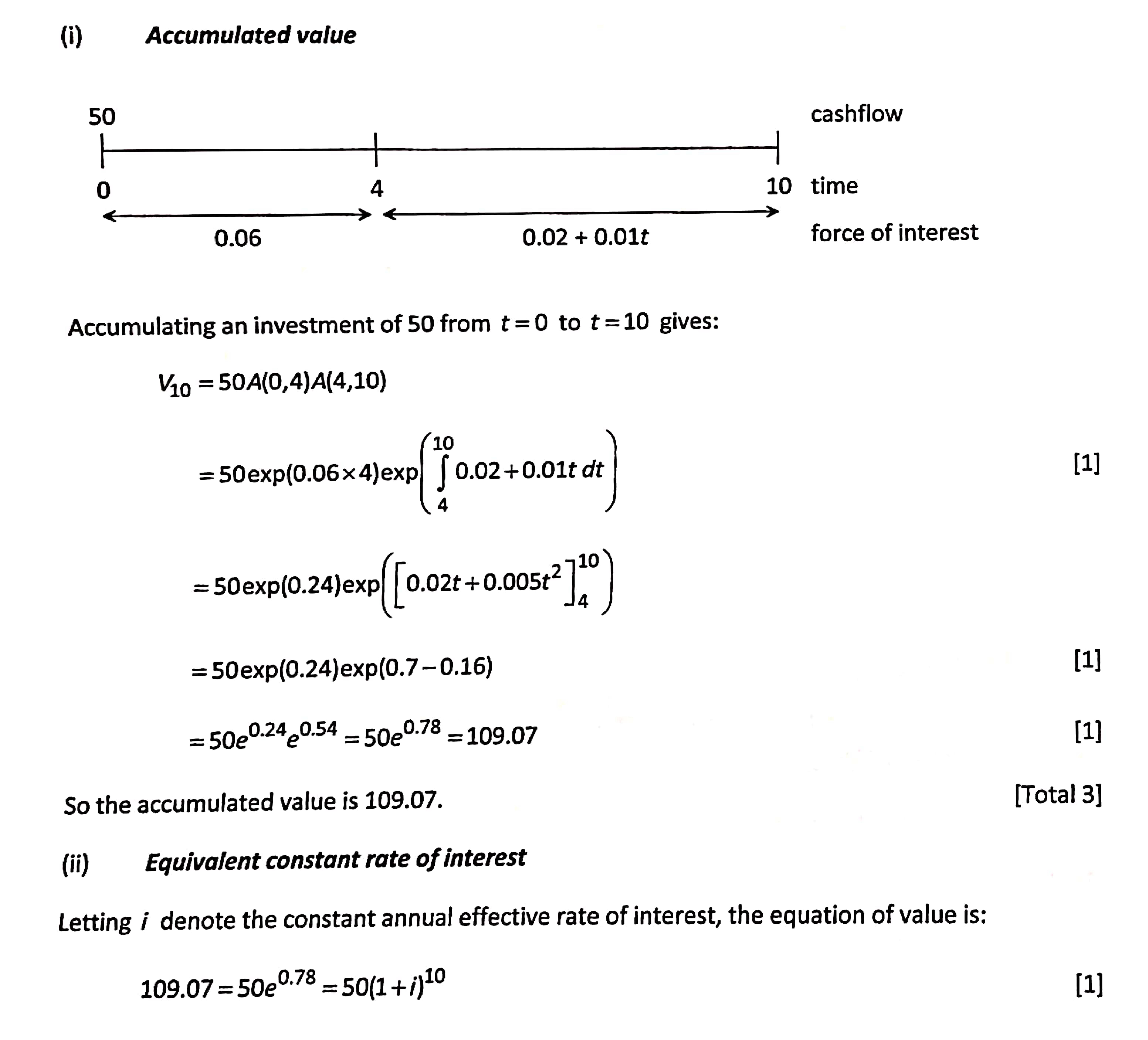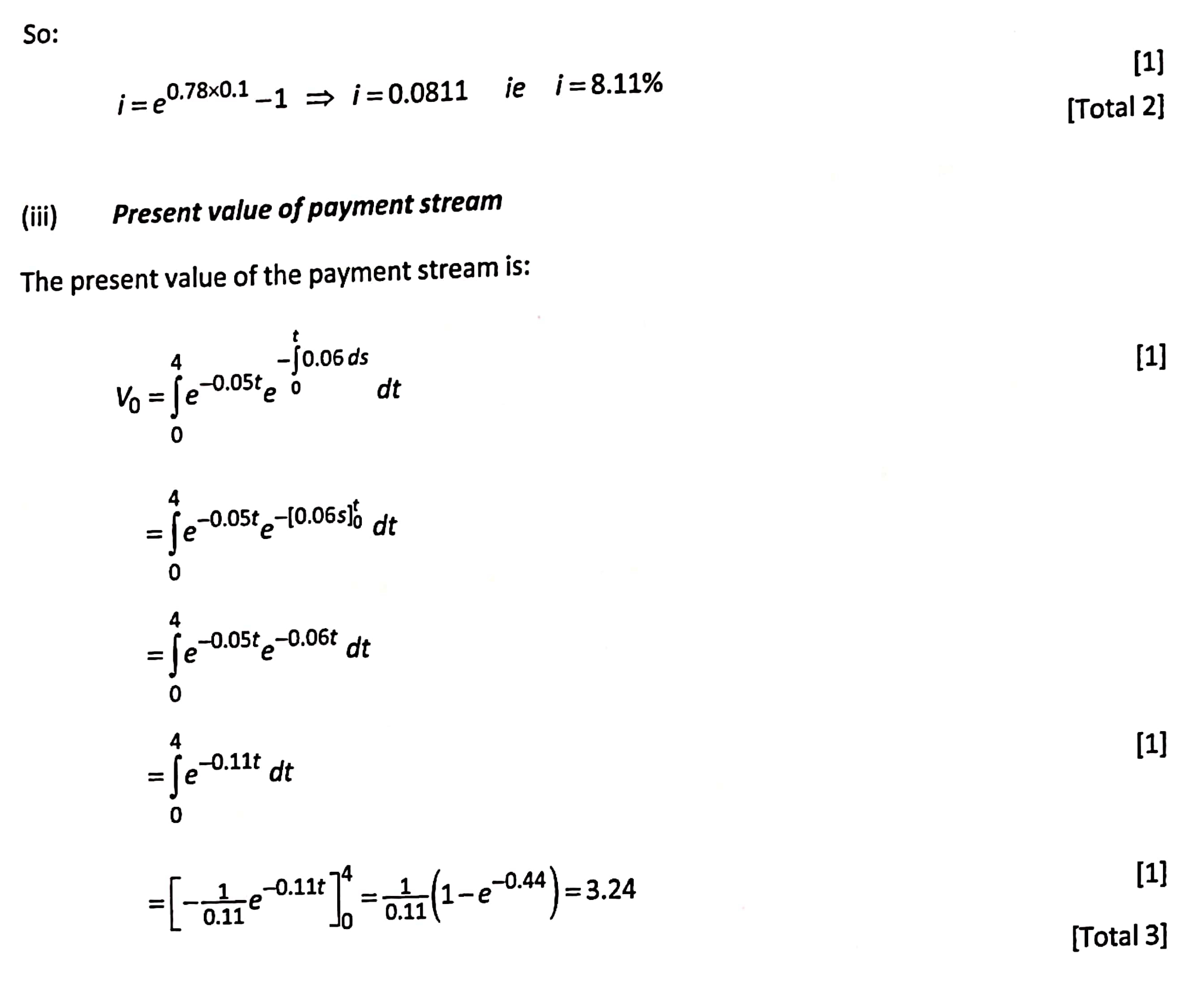探讨CT1利息理论中连续现金流的几种积分套路。

计算出上图的公式或许不能告诉你某家奶茶店的WiFi密码,但一定能给你的考试押中一道大题——无论你参加的是IFoA的CM1新体系考试还是学校里CT1(或新体系CM1)的免试认证,payment stream都是一道必考题。
对于payment streams,即连续支付的现金流,考试时一般考察两个点:
计算 present value
计算 equivalent constant force of interest
(2)中,计算 equivalent constant force of interest,只需要令(1)中计算出的现值和连续支付的等额年金现值公式相等即可。所以解题的关键部分是(1)计算现值。
考虑一个payment stream,从a时刻支付到b时刻,rate of payment为 \(\rho(t)\),利息力为\(\delta(t)\)。则该 payment stream 在 \(a\) 时刻的现值:
\[ PV=\int_{a}^{b}\rho(t)v(t)dt \] 其中: \[ v(t)=e^{-\int_{0}^{t}\delta(s)ds} \]
这就涉及到两个积分的计算。
往年 CT1 和2019年改革以后的 CM1 考试里,payment stream的利息力 \(\delta(t)\) 一般都是一个分段函数,并且是常数函数和关于 \(t\) 的一次函数的混合函数。
而 \(\rho(t)\) 在往年考试题中只出现过两种形式:常数函数和指数函数。以下的几个 Exercise 均为CM1真题风格。
\(\rho(t)\)为常数函数,\(\delta(t)\) 为常数函数
(更准确地讲,这里的 \(\delta(t)\) 可以是含有常数函数和关于t的一次函数的分段函数,但在payment stream需要积分的时间段里, \(\delta(t)\) 为常数函数)。
Exercise 1
An individual can obtain a force of interest per annum at time t , measured in years, as given by the formula: \[ \delta(t)=\left\{\begin{array}{ll}{0.03+0.01 t} & {0 \leq t<4} \\ {0.07} & {4 \leq t<6} \\ {0.09} & {6 \leq t}\end{array}\right. \]
- (i)Calculate the amount the individual would need to invest at time \(t = 0\) in order to receive a continuous payment stream of $3,000 per annum from time \(t = 4\) to t =10.
- (ii)Calculate the equivalent constant annual effective rate of interest earned by the individual in part(i).
我们来看第一小问。
\[ \begin{aligned} PV&=\int_{a}^{b}\rho(t)v(t)dt\\ &=\int_{4}^{10}3000v(t)dt\\ &=3000\int_{4}^{10}v(t)dt \end{aligned} \]
然后根据 \(v(t)=e^{-\int_{0}^{t}\delta(s)ds}\),对分段函数 \(\delta(t)\) 求积分即可。求得: \[ v(t)=\left\{ \begin{array}{cc} {e^{0.08-0.07t}} & {4 \leq t < 6}\\ {e^{0.20-0.09t}} & {6 \leq t \leq 10} \end{array} \right. \] 比较容易求得积分。可以得到: \[ \begin{aligned} P V &=3,000 \int_{4}^{6}\left(e^{0.08-0.07 t}\right) d t+3,000 \int_{6}^{10} e^{(0.20-0.09 t)} d t \\ &=\frac{3,000 e^{0.08}}{-0.07}\left[e^{-0.42}-e^{-0.28}\right]+\frac{3,000 e^{0.20}}{-0.09}\left[e^{-0.90}-e^{-0.54}\right] \\ &=4584.02+7172.83=\$ 11,756.85 \end{aligned} \]
\(\rho(t)\) 为指数函数,\(\delta(t)\) 为常数函数
(更准确地讲,这里的 \(\delta(t)\) 可以是含有常数函数和关于 \(t\) 的一次函数的分段函数,但在payment stream需要积分的时间段里, \(\delta(t)\) 为常数函数)。
Exercise 2
The force of interest at time t, where time is measured in years, is given by: \[ \delta(t)=\left\{ \begin{array}{cc} {0.06} & {0 \leq t<4} \\ {0.02+0.01 t} & {4 \leq t} \end{array} \right. \]
- (i)Calculate, showing all workings, the accumulated value at time t = 10 of an investment of 50 units at time \(t = 0\).
- (ii)Hence calculate the equivalent constant annual effective rate of interest implied by the transaction in (i).
A continuous payment stream is paid at a rate of \(e^{-0.05t}\) from time \(t = 0\) to time $ t = 4$.
- (iii)Calculate, showing all workings, the present value of this payment stream at time \(t = 0\).
我们来看第三小问。
先计算出 \(v(t)=e^{-\int_{0}^{t}0.06ds}=e^{-0.06t}\),代入公式,得: \[ \begin{aligned} PV&=\int_{0}^{4}e^{-0.05t} e^{-0.06t}dt\\ &=\int_{0}^{4}e^{-0.11t}dt\\ &=\left[-\frac{1}{0.11} e^{-0.11 t}\right]_{0}^{4}=\frac{1}{0.11}\left(1-e^{-0.44}\right)=3.24 \end{aligned} \]
可以发现,出题者让 \(\rho(t)\) 为指数函数,是为了方便考生的计算。因为 \(\rho(t)\) 和 \(v(t)\) 均形如 \(e^{-at+b}\) 和 \(e^{-ct}\),可以直接相乘得到 \(e^{-(a+c)t+b}\),容易求出积分。
出题人为了简化考生的计算也是煞费苦心了。
IFoA的官方教材机构ActEd的CMP中,还给出了一道“\(\rho(t)\)为关于 \(t\) 的一次函数,且 \(\delta(t)\) 为关于 \(t\) 的一次函数”的题。
\(\rho(t)\)为关于 \(t\) 的一次函数,\(\delta(t)\) 为关于 \(t\) 的一次函数
Exercise 3
The force of interest at time \(t\) is given by: \[ \delta(t)= \begin{array}{cc} {0.01t+0.04} & {0 \leq t \leq 5} \end{array} \] Calculate the present value at time 0 of a payment stream, received continuously from time 0 to time 5, under which the rate of payment at time \(t\) is \(0.5t+2\).
这就需要用到一个积分技巧: \[ \int_{a}^{b} f^{\prime}(t) e^{f(t)} d t=\int_{a}^{b} e^{f(t)} d f(t)=\left[e^{f(t)}\right]_{a}^{b} \]
所以,我们有:
\[ \begin{aligned} PV&=\int_{0}^{5}(0.5 t+2) \exp \left(-\int_{0}^{t}(0.01 s+0.04) ds\right) dt\\ &=\int_{0}^{5}(0.5 t+2) \exp \left(-\left[0.005 t^{2}+0.04 t\right]\right) d t \\ &=-50 \int_{0}^{5}-(0.01 t+0.04) \exp \left(-\left[0.005 t^{2}+0.04 t\right]\right) d t \\ &=-50\left[\exp \left(-\left[0.005 t^{2}+0.04 t\right]\right)\right]_{0}^{5} \\ &=-50(\exp (-0.125-0.2)-\exp (0)) \\ &=13.87 \end{aligned} \]
出这样的题得预先凑好两个一次函数,以便考生能够把该积分技巧用上。
如果要考察分部积分法,我们还可以这样出题。
\(\rho(t)\) 为关于 \(t\) 的一次函数,\(\delta(t)\) 为常数函数
我们将 Exercise 2 的题稍做改编,令 \(\rho(t)=t+5\)
Exercise 4
The force of interest at time \(t\), where time is measured in years, is given by: \[ \delta(t)=\left\{\begin{array}{cc}{0.06} & {0 \leq t<4} \\ {0.02+0.01 t} & {4 \leq t}\end{array}\right. \] A continuous payment stream is paid at a rate of \(t+5\) from time$ t = 0$ to time \(t = 4\). Calculate, showing all workings, the present value of this payment stream at time \(t = 0\).
同样地,代入公式得: \[ \begin{aligned} PV&=\int_{a}^{b}\rho(t)v(t)dt\\ &=\int_{0}^{4}(t+5)e^{-\int_{0}^{t}0.06ds}dt\\ &=\int_{0}^{4}(t+5)e^{-0.06t}dt\\ &=e^{0.3}\int_{0}^{4}(t+5)e^{-0.06(t+5)}dt \end{aligned} \] 换元,令\(y=t+5\),则: \[ PV=e^{0.3}\int_{5}^{9}ye^{-0.06y}dy \] 再用分部积分法即可求出答案。
这样我们就考察了了学生分部积分法的运算能力。
拓展
个人认为CM1的考题出到这个程度已经够了,出得再难意义不大。不过结合我们学过的高数知识,我们可以进一步思考,题目还能怎么出?
\(\rho(t)\) 为常数函数,\(\delta(t)\) 为关于 \(t\) 的一次函数
此时要处理的积分式形如 \(\int_{a}^{b} e^{t^{2}} d t\),
根据正态分布的概率密度函数可以求解。
\(\rho(t)\) 为关于 \(t\) 的一次函数,\(\delta(t)\) 为常数函数
通过换元等步骤简化,最终要处理的积分式形如 \(\int_{a}^{b} x e^{x} d x\),
用分部积分法即可求解。
\(\rho(t)\)为关于 \(t\) 的一次函数,\(\delta(t)\) 为关于 \(t\) 的一次函数
此时要处理的积分式形如 \(\int_{a}^{b} x e^{x^{2}} d x\),
\(\int_{a}^{b} x e^{x^{2}} d x=\frac{1}{2} \int_{a}^{b} e^{x^{2}} d\left(x^{2}\right)\),又可以转化成正态分布的概率密度函数求解。
Exercise 的完整答案
最后附上前面几道 Exercise 的完整答案:
Solution 1

Solution 2


Solution 3
